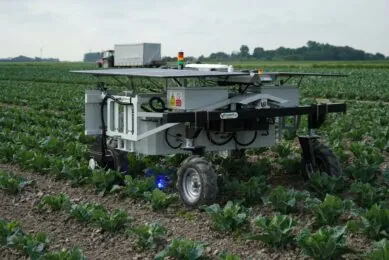Why the overall adoption rate of agricultural robots is still low

In comparison with other industries the agricultural industry has been slow to digitise, according to a market research report by IDTechEx. The report also lists reasons why the overall adoption rate of agricultural robots is still – relatively – low.
IDTechEx’s new report ”Agricultural Robotics Market 2022-2032” provides an overview of the stage of commercialisation and market size for different applications.
High upfront costs
According to Yulin Wang, Technology Analyst at IDTechEx and one of the authors of the report, it is important to note that in comparison with other industries (e.g., mining, logistics, delivery, etc.), the agricultural industry has been slow to digitise. Several reasons for this include high upfront costs, low margin of the agricultural industry, insufficient trust from farmers, and lack of robustness of agricultural robots.
Nevertheless, with the rapid evolution of the technologies, along with the increasing technical robustness and trust-gaining ability of robots, more and more people start to realise the potential in agricultural automation.
Agricultural robots market to grow to 13 billion USD by 2032
IDTechEx believes that the market for agricultural robots will remain strong during the upcoming decade, with a two-digit growth rate per year. According to their report the global market will reach around 13 billion USD by 2032.
The graph below shows application areas by market size and technical difficulty. – Source: IDTechEx

Still, compared to other industries, adoption of agbots is relatively slow, and this is why according to the researchers:
- Lack of trust – unlike other industries, the agricultural industry has relatively low margins, and farmers typically only have one chance per year for seeding and harvesting, meaning that the failure of robots could directly lead to the loss of a farmer’s annual income. Therefore, unless the robots have sufficient technical robustness and trustworthiness to mitigate the potential risks, farmers are still hesitant to use these machines.
- High costs – even though the costs of buying/leasing robots have been decreasing over the past several years, the upfront investment for robots still seems to be a big financial pressure for farmers. The agriculture industry itself has a low margin, which makes farmers hesitant to make this investment. However, the Robotics-as-a-Service model provides a promising solution for this as farmers can choose to rent the robots whenever they want rather than purchasing the entity.
- Lack of geographical availability due to the lack of IT infrastructure – although the technologies used in agricultural robots have been improving for several years, they are still far from being deployed everywhere. One of the biggest challenges of Agbots is the communication system (e.g., WiFi, cellular, etc.). Communication systems require the support of IT infrastructure, however, farms are typically located in rural areas where the infrastructure is very limited. Therefore, the coverage of 3G, 4G, and beyond remains a barrier.
- Lack of sufficient funding and sensitive nature – developing an Agbot requires millions in capital to scale and research. However, Venture Capitals (VCs) rarely make investments in these companies due to the long payback time, immature technologies, and limited applications. Therefore, those early start-ups are struggling to raise funding and scale up their business.
Join 17,000+ subscribers
Subscribe to our newsletter to stay updated about all the need-to-know content in the agricultural sector, two times a week.



